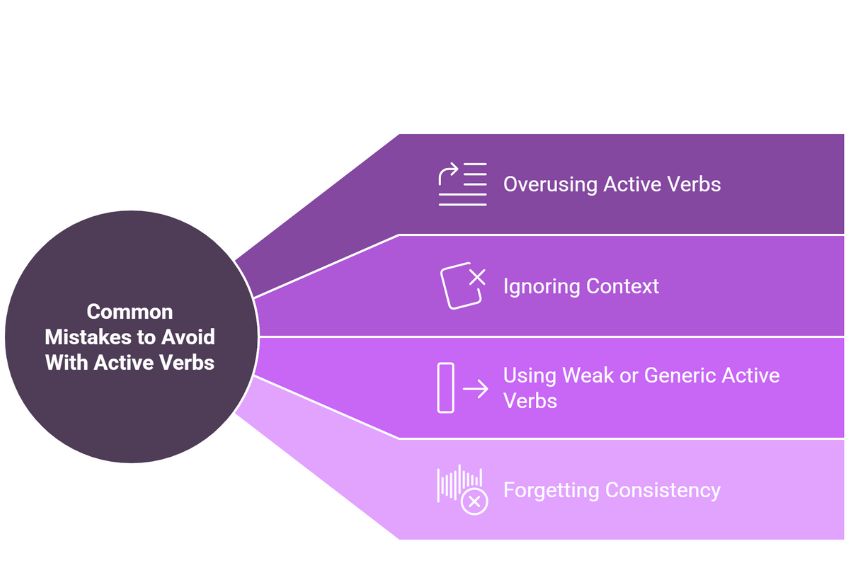Ever feel like your writing lacks energy or impact? The secret might lie in the verbs you use. Active verbs are the powerhouses of language, they bring sentences to life, making them more dynamic and engaging. Whether you’re telling a story, writing an essay, or crafting an email, using the right verbs for creative writing can make all the difference.
In this blog, we’ll explore what active verbs are, why they matter, and how you can use them to transform your writing. From understanding the basics to practical tips and exercises, this guide will equip you with everything you need to master these verbs. Let’s dive in and discover how these small but mighty words can elevate your writing to the next level!
What Are Active Verbs?
Active verbs are action-packed words that bring life to your sentences. They show what the subject of the sentence is doing rather than what’s being done to it. These verbs are direct, clear, and make your writing more impactful. Here’s a quick example:
| Active Sentence | Active Verb | Passive Sentence | Active Verb in Passive Sentence |
| The cat chased the mouse. | Chased | The mouse was chased by the cat. | Chased |
| She solved the problem. | Solved | The problem was solved by her. | Solved |
| The team developed the app. | Developed | The app was developed by the team. | Developed |
| He wrote the report. | Wrote | The report was written by him. | Written |
| They cleaned the house. | Cleaned | The house was cleaned by them. | Cleaned |
Notice how the active verb version feels more lively and straightforward? Even in passive sentences, the same verb remains the action word (active verb). However, in active sentences, the subject is performing the action, making the sentence more direct. This style is especially useful when developing argumentative writing skills, where strong, active sentences help you present your points with greater impact and confidence.
Characteristics of Active Verbs
Show action: They describe what the subject is actively doing (“run,” “build,” “explore”).
Are concise: These verbs make sentences shorter and easier to understand.
Keep the focus on the subject: They highlight the doer of the action, making your writing more engaging.
Action Verbs for Everyday Use
| Run | Jump | Write |
| Build | Solve | Clean |
| Paint | Cook | Design/Develop |
Creative Active Verbs for Storytelling
| Whispher | Scream | Explore |
| Discover | Escape | Ignite |
| Chase | Dream | Leap/Shatter |
Professional Active Verbs for Formal Writing
| Manage | Lead | Create |
| Analyse | Achieve | Plan |
| Innovate | Nagotiate | Present |
Why Active Verbs Matter?
Now that you know what active verbs are and have seen examples, let’s see their unique impact on different types of writing. They aren’t just about energy, verbs adapt to make your message clear and compelling in any context.
Benefits of Using Active Verbs
1. Clarity and Precision – active verbs help you get straight to the point. They eliminate unnecessary words and make your sentences easier to understand. For example :
Passive: “The report was written by Sarah.”
Active: “Sarah wrote the report.”
The second sentence is clearer and more direct.
2. Engagement – when you use active verbs, your sentences feel alive. They draw readers in and hold their attention, whether you’re writing a story, an email, or an essay. For example :
Passive: “The ball was kicked by the player.”
Active: “The player kicked the ball.”
3. Conciseness – active verbs help you express ideas with fewer words, making your writing concise. For example:
Passive: “The project was successfully completed by the team.”
Active: “The team completed the project successfully.”
Shorter, sharper sentences leave a stronger impression.
Bonus Tip: Active Verbs in Action
Think of active verbs as the backbone of your sentences. When you choose them carefully, your writing becomes more vibrant and engaging. To further improve your writing, explore other important English Language Features that contribute to engaging communication.
3 Practical Tips for Using Active Verbs
Using active verbs effectively can transform your writing, but where do you start? Here are some quick, actionable tips to help you master active verbs and make your sentences more interesting.
Tip 1 – Identify the ‘Doer’ of the Action
Begin by finding the subject of your sentence. Ask yourself, “What is it doing?” This helps you construct sentences that are clear and action-driven.
For example: Instead of “The ball was hit by the boy,” write “The boy hit the ball.”
Tip 2 – Use Strong, Vivid Verbs
Replace weak verbs like “is” “are” or “was” with dynamic, specific action words. Strong verbs create a stronger impression and make your writing more engaging.
For Example: Replace “She is making progress” with “She progresses.”
Tip 3 – Read Your Sentences Aloud
Reading aloud helps you identify awkward or passive-sounding phrases. When a sentence feels clunky, check if an active verb can make it smoother and more impactful.
For Example: If “The cake was eaten by the kids” sounds off, switch it to “The kids devoured the cake.”
Common Mistakes to Avoid with Active Verbs
While active verbs can transform your writing, there are a few common mistakes writers often make. Avoiding these mistakes ensures that your sentences remain clear and natural.

Visualising These Mistakes
Overusing Active Verbs:
Example of Overuse: “He sprinted to the door, yanked it open, bolted outside, and slammed it shut.”
Improved Version: “He sprinted to the door, opened it quickly, and stepped outside.”
Ignoring Context Example:
Passive: “The vaccine was administered to 500 participants.” (Focus is on the action of administering.)
Active: “The doctors administered the vaccine.” (Focus shifts to the doers.)
Using Weak or Generic Active Verbs
Example of Weak Verbs: “She made a decision to leave.”
Improved Version: “She decided to leave.”
How to Avoid These Mistakes?
To make the most of active verbs, it’s essential to revise and simplify your writing. After finishing a draft, read your sentences aloud to identify any overuse of active verbs or unnecessary complexity. Focus on clarity by choosing verbs that precisely convey the action you want to emphasise.
Additionally, use passive voice sparingly, reserving it for situations where it genuinely serves the purpose of the sentence. By avoiding these common mistakes, you can ensure that active verbs enhance your writing without overwhelming your readers.
Let’s Practise: Active Verbs in Action!
Ready to put your skills to the test? Try these simple exercises to practise using active verbs and make your writing more dynamic.
Rewrite These Sentences:
Transform the following passive sentences into active ones:
- The cake was eaten by the children.
Hint: Focus on the children as the subject. - The project was completed by the team.
Hint: Start with “The team…” - The letter was delivered by the postman.
Hint: Who performed the action here? - The problem was solved by the engineer.
Hint: Highlight the engineer’s action.
What can you do next? you can always challenge yourself. Take a paragraph you’ve recently written and scan for passive sentences. Rewrite them using active ones. By practising regularly, you’ll get used to using active verbs and notice a huge improvement in your writing style. Keep practising!
Resources for Practising
If you want to practise further you can visit these websites :
Games4esl : This platform offers interactive exercises to practise action verbs, including flashcards, matching activities, memory games, and spelling practise.
Quizlet : You can test yourself with cards and make practising more fun.
Grammarly : A free tool that identifies passive voice and suggests active verb replacements.
ProWritingAid : Offers detailed suggestions for improving sentence clarity, including active verb usage.
Conclusion
Active verbs are important for effective writing, but the key is knowing when and how to use them. With the right verbs, your writing becomes more purposeful, and your ideas become easier to express.
By focusing on the action and the doer, you bring clarity to your text without overcomplicating it.
As you continue to write, start applying the tips and exercises to make your work stronger. if you think you need extra help or want to improve further, online tutoring can provide personalised support to help you reach your writing goals. Take the time to experiment with these verbs and watch your writing evolve.








